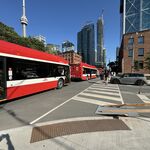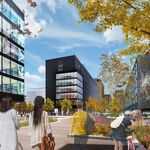Sixty-two years ago, William Gallancy, an associate engineer with New York State’s Department of Public Works, told a standing-room-only crowd at St. James Evangelical and Reformed Church on High Street that the Kensington Expressway was the best solution to East Buffalo’s problems. Traffic congestion on the neighborhood’s thoroughfares was bad and getting worse, he explained. “Gallancy said 70,000 vehicles a day cram that section’s main arteries—Main, Kensington, Genesee, Bailey and Walden,” according to a Buffalo News account of the meeting. “And, he added, the growth of suburbs and congestion of traffic continues to increase at a tremendous rate.
“Unless something is done to relieve this congestion, he said, property values will drop alarmingly. ‘It is doing more to depress property values than anything else,’ he warned. ‘We must save the city from becoming a backyard for its suburbs.’”
Well. That certainly didn’t work.
The $45 million Kensington Expressway tore up Frederick Law Olmsted’s tree-lined Humboldt Parkway, claimed hundreds of homes in previously stable neighborhoods, ripped a trench in the ground that emphasized the city’s racial division, and diverted automobile traffic from the East Side’s once-thriving business strips to a limited-access expressway that shuttles commuters from downtown Buffalo to the northern suburbs in about 10 minutes on a clear day.
In other words: Making the city a backyard to its suburbs. Depressing property values. Starving small businesses on Jefferson and Fillmore of customers and abetting the evisceration of those business districts. Subjecting two generations of residents surrounding the expressway to air and noise pollution.
Read more:
http://artvoice.com/issues/v9n9/bury_this_big_mistake#ixzz0hGLjxSkk
...
According to Craig Mozrall of NYSDOT, there are five design options under consideration. First, the do nothing option. Second, simply improve retaining walls and railings, plus landscaping, which is what is happening between Jefferson and Michigan now.
The next two options involve capping the Kensington between Best Street and Delavan Avenue. The trench that carries the Kensington is not deep enough to be capped as is, so the first capping option envisions a surface median that is raised four feet above grade, with two lanes of traffic on each side of a landscaped parkway. The second capping option is slightly more dramatic: It entails digging the trench four feet deeper, resurfacing the expressway, then building the new parkway at grade over top.
Finally, there’s the fifth option introduced by Mayor Brown last summer: Fill in the expressway and replace it with an at-grade, tree-lined urban boulevard comprising eight lanes. In each direction there would be a slip road and three inner lanes, with parkway in between. In his August letter, Brown referred NYSDOT to the Central Freeway Replacement Project in San Francisco, in which an urban expressway was demolished and replaced with an expanded Octavia Boulevard, removing what many considered a blight on the city’s landscape and injecting the proximate business district with new vitality, while managing to accommodate the displaced traffi
Read more:
http://artvoice.com/issues/v9n9/bury_this_big_mistake#ixzz0hGMkmA8X




